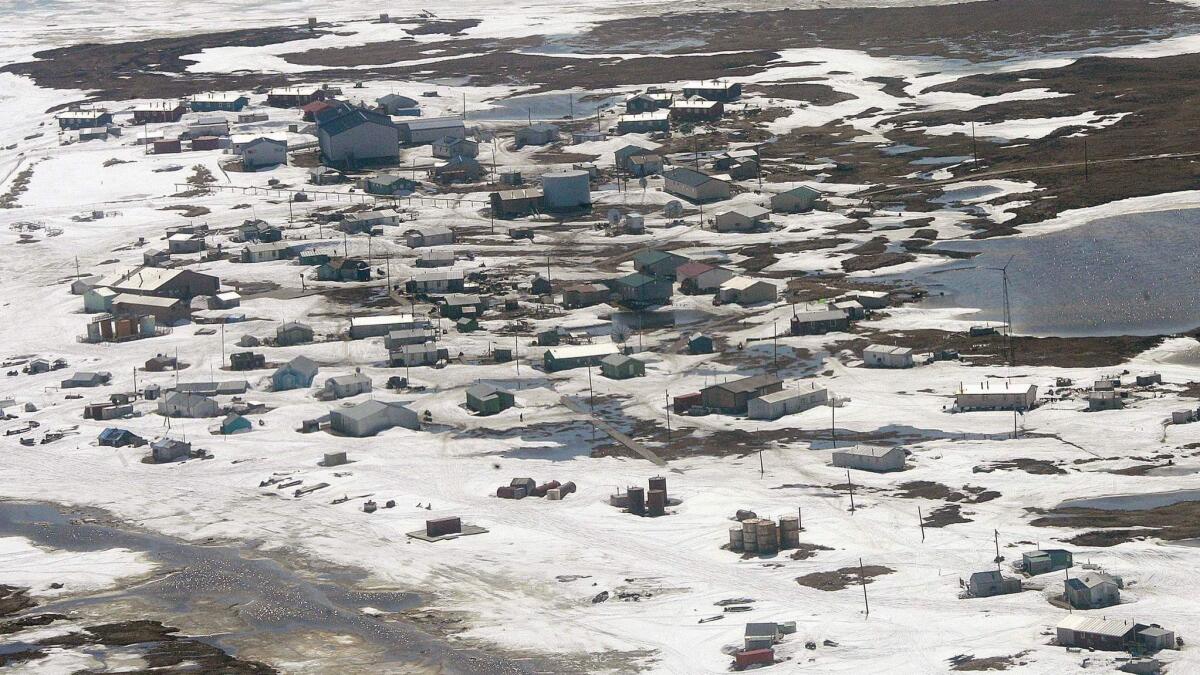Op-Ed: Dear media: We need more stories about resilience to climate change

- Share via
Overwhelmed by climate change? It’s not your fault.
Actually, you are to blame for climate change. But it’s the media’s fault for making you feel completely hopeless about it.
That includes me. As a correspondent for NPR 10 years ago, I did a story on Newtok, a remote Yupik community in northwest Alaska that was both sinking and eroding because of the effects of global warming. In the decade since the report aired, hundreds of national and international reporters have visited Newtok, and a dozen other Alaskan communities like it, to document the effects of climate change.
The stories all fit the same narrative. With somber music, images of houses and schools tipping precariously off cliffs and phrases like “impending doom,” the reports paint a picture of tragedy and hopelessness and frame the residents as victims, climate change “refugees” whose communities are one bad storm away from ceasing to exist.
The repetition of this narrative over the last 10 years has done little to help. There is still no dedicated agency or funding at the federal level to address climate-induced relocation. And while the public is slowly accepting the reality of warming, even those identified as the most alarmed say they don’t really know what to do about it.
The threats posed to humans, polar bears and entire ecosystems are recounted on a daily basis, leading to what researchers call a ‘hope gap.’
This familiar narrative, about communities facing sea level rise and coastal erosion, fits into a larger pattern of climate change coverage. The threats posed to humans, polar bears and entire ecosystems are recounted on a daily basis, leading to what researchers call a “hope gap.” With little offered in the way of action or response, people eventually tune out: “We’re doomed. What’s on Hulu?”
As someone who lives in Alaska and has been to the North Pole twice, I’ve got a pretty good idea of how bad it is. What I’d like to know more about is what people are doing to counter it. I want to know how cities are meeting emissions targets in spite of the Trump administration’s environmental rollbacks. I want to know that the fastest-growing job in the country is solar panel installer.
I’m not alone, apparently. A surprising number of scholars are studying how the public responds to climate news. There’s even a Media and Climate Change Observatory that keeps daily track of climate-related stories. In 2004, its founder, Max Boykoff, was among the first to identify a trend of “false balance” in the early reporting. That’s the practice of pairing a contrarian view from an organization skeptical of climate change to “balance” the view of a reputable climate scientist. Several years later, Boykoff took another look and found that most news organizations had self-corrected. More recently, he called attention to a “trend of daily fear, misery and doom” that leaves audiences feeling powerless.
This doesn’t mean we should stop reporting the terrifying realities. But it does mean we need to start telling stories about effective responses: practical, replicable examples of how individuals, businesses and governments are tackling climate change. It may smack of advocacy, but what self-respecting public health reporter would do a story about an epidemic without including information about an available vaccine or how to avoid infection?
Take Newtok, for example. That community is not waiting and watching helplessly as homes are erased by the sea. Quite the opposite is true: It’s a place where indigenous people are adapting in order to stay in a region where they’ve managed to weather wrenching environmental and cultural change for thousands of years.
Newtok residents have spent the last decade raising money, navigating a bureaucratic morass and collaborating with everyone from the local Lions Club to the Department of Defense in order to move just nine and a half miles away. Their new community is taking shape on firm volcanic rock. It’s called Mertarvik, which means “place to get water,” because it has a fresh water spring, something the old site lacks. Community members have built seven energy-efficient homes. They’re building another four this summer, and 13 refurbished military barracks are scheduled to arrive by barge. State agencies will soon be required to fund a new school, an airstrip and public utilities.
The process of relocating a community is painfully incremental, but it’s one that should be documented for the same reason so many news organizations sent reporters to Newtok in the first place. Although Newtok’s plight was broadcast as a harbinger of tragic things to come, its response might serve as a model for the coastal and island communities around the world facing the same threat.
If we journalists were able to self-correct for false balance, surely we can self-correct for an overly narrow narrative that amounts to a steady drip of catastrophic predictions. Newtok, a community “doomed” by climate change, has figured out how to adapt — one innovative idea, one grant, one barge load at a time. It will not cease to exist. In fact, life might even be a little bit better on higher, more solid ground and with fresh water. It’s a story worth telling.
Elizabeth Arnold is a Shorenstein fellow at Harvard’s Kennedy School and a journalism professor at University of Alaska Anchorage. She was previously a correspondent for National Public Radio.
Follow the Opinion section on Twitter @latimesopinion or Facebook
More to Read
A cure for the common opinion
Get thought-provoking perspectives with our weekly newsletter.
You may occasionally receive promotional content from the Los Angeles Times.









